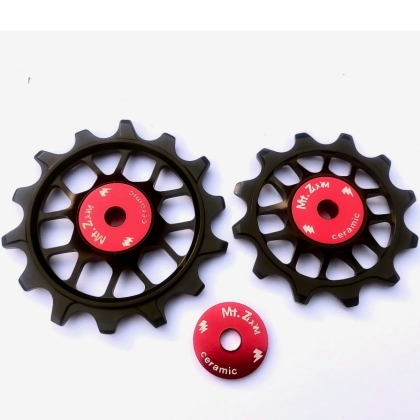Product Review
Mt Zoom Ultralight flat bar - Review
Share on Facebook Share on TwitterBY: Paddy Atkinson
Published: 25th June, 2014
This isn’t a scientific, objective, peer reviewed and 100% organic review. This is more like my opinion, but given the amount of stuff I break, it should give you a pretty good idea if something is any good or not.
What Mount Zoom do, is cut out this part of the process, getting bars directly from the factory and passing them on to the consumer at far lower prices than big brands, even coming from the same factories. All good so far then.
I’d wanted to try some wider bars for a while, going from 640mm to 680mm over 2013, so 710mm seemed like the next logical step. I also prefer not to look like I’ve ridden straight out of the 90s on a Klein Attitude, so the slightly lighter, non-bar-end friendly model is my choice. Even with the generous width, they tip the scales at 118g (claimed, I don’t have the scales or patience to weigh them), putting them among the lightest bars around. Of course you could get some German über-bars that are 20g lighter, but they’d set you back a few hundred quid, rather than the modest £94.97 that Mt Zoom are selling these for. There are also a load of options available, widths from 580mm to 740mm, bar end friendly and not, and even riser bars. So they tick the weight and price boxes.
Bar shape is very much a personal thing, but if you are after an aggressive XC racing position, especially on a 29er, these should work well. There’s no rise or upsweep at all, keeping the front end low, and the minimal 4 degree back sweep puts you in a forward stance ready to attack the climbs. They also look great (in my opinion), although if you’re a fan of loud, bright coloured components you’d best look elsewhere. For the rest of us though, the matte black (more subtle and classy than the 3K weave finish of older Mt Zoom bars) finish and silver logos should look good with any colour scheme. There’s also an almost invisible grid pattern at the centre, helping with stem alignment, and marks for cutting them down. Another nice feature is the textured, grippy sections in the centre and ends of the bar, helping eliminate slippage and reducing the amount of torque needed.
I’ve been using these since the start of the season, racing three national XC rounds, several regional races, and a few winter endurance type things. In that time, I’ve crashed into trees (an embarrassing amount of times), stuffed the bars into rocks, bent brake levers, and done plenty of dodgy whips. The bars have taken all this in their stride. One crash resulted in a load of gravel being pushed down the end of the bar, along with the remains of a bar end. While this did make a bit of a scar on the internal surface, Ant (the man behind the company) assured me that it’d be fine, and I’ve ridden on it since then without any problems. It did take me a bit of time to get used to the very straight shape, but after a few rides it felt natural. They definitely do go against the minor trend for shopper bike shaped, U-shaped bars, but this is no problem unless you’ve got something seriously wrong with your wrists, or like your steering sticks to look like a long moustache. One thing that I did notice is that my grips seem to be wearing faster at the outer end than with a narrower, more swept back bar. I’d rather have that than a different bar shape though, and ESI grips are cheap enough to make it a non-issue.
When riding, I haven’t noticed any flex or deflection from these, you just point them where you want the bike to go, and they do it without question. They’re by no means uncomfortably stiff though, and I haven’t had any of the buzzing palms and numb fingers that an overly rigid front end can potentially cause.
“But light carbon bars aren’t strong enough to handle my gnarly #enduro riding!” This always seems to be the default response on forums to any light components. A quick internet search will bring up plenty of pictures of snapped bars of all brands, carbon, titanium and aluminium, and plenty of scaremongers trying to convince you that carbon fibre isn’t strong enough for everyday use. The truth is that any fool without a torque wrench can break any pair of bars. Most instances of bars breaking are because of over-tight controls, meaning that when the brake levers dig into the ground they grip and twist, eager to break things. I have some first-hand experience of this, after a close encounter with the floor at Hadleigh Farm last year.
With this in mind, the bars come with torque instructions that may seem quite low at first, but you’ll realize that it’s all that’s needed. I've had a few crashes where this has happened, and rather than a new pair of bars and brake lever, all that was needed was an allen key to spin the lever back into position.
They're plenty strong then – they’re still going well under me and a whole host of other racers.
So, these bars are stiff, (very) light, good looking, strong and affordable. Unless you’re a fan of bright colours and loud logos, what’s not to like?
Blogger Info:

Paddy Atkinson
I've only been racing since early 2012, but been mountain biking since the age of 10. I try to balance training and A-level studies, then you get to read about it on here!
Thanks to XCracer, Scimitar, MtZoom, Accelerade and Exposure for all the help.
Disclaimer:
This blog post was written by a third party and their views do not necessarily reflect the views of XCRacer.com
Contact Us | Advertise | Use Our Online Entry System
All content © XC Racer.com | Website Designed and Developed by DesignUNLTD
